Broadband antenna with multiple associated patches and coplanar grounding for RFID applications
a wideband patch and coplanar ground technology, applied in the direction of antennas, antenna details, basic electric elements, etc., can solve the problems of poor performance of the overall rfid system and application failure, the design of the reader antenna becomes critical, and the situation is more complex and cannot be thought of as simply near-field or simply far-field, etc., to improve the electric or magnetic field strength or shape around the antenna. , control, optimize the effect of the electric or magnetic field strength or
- Summary
- Abstract
- Description
- Claims
- Application Information
AI Technical Summary
Benefits of technology
Problems solved by technology
Method used
Image
Examples
Embodiment Construction
[0042]Embodiments and applications of the current invention will now be described. Other embodiments may be realized and changes may be made to the disclosed embodiments without departing from the spirit or scope of the invention. Although the embodiments disclosed herein have been particularly described as applied to the field of RFID systems, it should be readily apparent that the invention may be embodied in any technology having the same or similar problems.
[0043]In the following description, a reference is made to the accompanying drawings which form a part hereof and which illustrate several embodiments. It is understood that other embodiments may be utilized and structural and operational changes may be made without departing from the scope of the descriptions provided.
[0044]FIG. 1 is a drawing showing a patch antenna from the prior art. In this design the supporting dielectric material 100 separates the radiative antenna element 110 (top side of the dielectric) and the refer...
PUM
 Login to View More
Login to View More Abstract
Description
Claims
Application Information
 Login to View More
Login to View More - R&D
- Intellectual Property
- Life Sciences
- Materials
- Tech Scout
- Unparalleled Data Quality
- Higher Quality Content
- 60% Fewer Hallucinations
Browse by: Latest US Patents, China's latest patents, Technical Efficacy Thesaurus, Application Domain, Technology Topic, Popular Technical Reports.
© 2025 PatSnap. All rights reserved.Legal|Privacy policy|Modern Slavery Act Transparency Statement|Sitemap|About US| Contact US: help@patsnap.com



